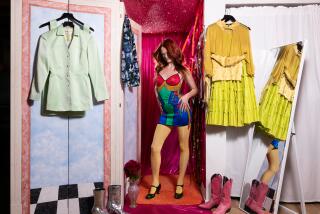Green’s Berets
A dying breed after pillboxes went out in the 1960s, milliners are back in fashion.
The rapid growth of Santa Monica-based Louise Green Millinery paralleled a sharp increase in women’s hat sales during the last decade.
Green, a British expatriate who began designing and handcrafting vintage-inspired hats on her living room floor 10 years ago, now runs one of the country’s most respected high-end milliners. Her hats, which retail from $75 to $300, are sold at Neiman-Marcus, selected Nordstroms, Saks Fifth Avenue and upscale boutiques.
Timing played a big part in the success of the company, which did $1 million in business last year.
“In the late ‘80s, Louise’s sense of design came in sync with the retro movement in apparel,” said her husband, Lawrence, who manages the business end of the company.
*
She started out almost accidentally, buying thrift-store hats and restyling them with lace and other vintage-style trimmings. They sold so quickly, she sought out one of the only women in the area still teaching the art of making hats by hand: an African American named Wilma Ray Gordon, who taught hat-blocking in a weekly sewing circle in her home. Many African American women have been stalwart hat wearers, particularly for church attendance, even when hats fell out of popularity with other markets.
Green started shopping her hats around to upscale boutiques around Los Angeles, and her work soon outgrew her living room. She now operates out of a 6,000-square-foot factory in Santa Monica that employs a secretary, a production manager, a shipper, two hat blockers, two hand-sewers, two trimmers and three machine operators.
*
Most milliners who continue to hand-block hats (as opposed to shaping them by machine in mass production) are small operators, many of whom have day jobs and create their hats at night and on weekends. Few break through, as the Greens have, to become widely known in the fashion industry.
But industry officials say interest in millinery is increasing.
“Every day, I get at least one call from someone starting out in the business,” said Casey Bush, director and founder of the Headwear Information Bureau, a New York-based nonprofit association that promotes the industry.
Industry sales have increased 10% to 15% a year since the mid-1980s in all price points, she said. Based on reports from the bureau’s member companies, retail sales for 1997 in women’s hats topped $830 million.
“Design talent isn’t enough to succeed in this business. That’s only a part of it,” said Louise Green, who HIB named Millinery Designer of the Year for 1997.
“You also have to want to be successful, be a little pushy and get your designs out there as much as possible. You need sales reps, a color catalog, a presence at the trade shows, and uncompromising quality and service. We have done all that.”
For Green, hat design has always meant more than a career: It’s a passion. “I always wore hats in England,” said Green, who still wears hats and berets of her own making nearly all the time.
Most of Louise Green’s hats have what the designer calls “a retro feeling, but for the modern woman.”
After studying color forecasts from the fashion industry, she creates “storyboards” filled with fashion photos and material swatches. Green designs about 250 hats each fashion season, utilizing about 50 hat shapes, from wide-brimmed “picture” hats (often seen on catalog or fashion magazine layouts) to cloches.
The Greens realize there is a limit to how far the market for whimsical hats can expand. With other talented designers vying for a piece of the market, the Greens consistently innovate. Two years ago, they patented a “one-size-fits-most” silk-covered elastic band that is sewn into the hats for a more secure fit. This year, they added soft, “packable” hats that have become popular with women travelers.
The Greens say another key to their success is that they emphasize reliability and service.
“We don’t let people down,” Louise said. “If we say we’ll ship in one week, we ship in one week. We also bend over backwards for our customers. If a retailer calls and says a customer is getting married in two weeks and needs a hat, we will make one up and get it to them.”






